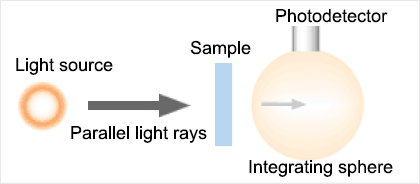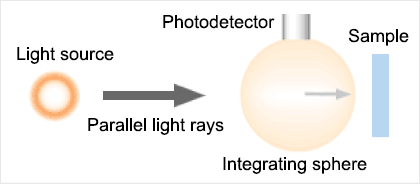Nittobo Group strives to contribute to the realization of an enriched society,
serves as a valued corporate group in society, and commits to the creation of comfortable life.
Verre Screen │ Optical and thermal performance
Optical performance
What is transmittance and reflectance?
| Transmittance | Transmittance refers to the ratio of light transmitted under the condition where 100% transmittance is achieved when there is nothing that blocks the light. |
|---|---|
| Reflectance | Reflectance refers to the ratio of light reflected if the amount of light reflected by a mirror (reflective plates, such as designated aluminum deposited for measurement) is 100%. |
What is the measurement method?
As there are no standards for measuring diffuse light transmittance/reflectance of cloth materials such as Verre Screen, these are measured (measured within the range of 300 to 2,100 nm using a spectrophotometer) by adopting the measurement method for flat glasses.
JIS R 3106: Testing method on transmittance, reflectance, and emittance of flat glasses and evaluation of solar heat gain coefficient

Conceptual diagram of transmitted light measurement
Light emitted by a light source is measured by a photodetector when it passes through a sample and is captured by an integrating sphere.

Conceptual diagram of reflected light measurement
Light emitted by a light source is measured by a photodetector when it is reflected by a sample and captured by an integrating sphere.
What is the length of light waves?
Natural light consists of light having different wavelengths (frequencies). The range of light visible to the human eye is called "visible light," and outside the range are ultraviolet and infrared rays.

Classification of light wavelengths
Calculation and correction of numerical values
Rates are calculated by weighting individual measured values and correcting them slightly for integration.
Transmittance and reflectance are calculated using the respective methods mentioned above, and the result of multiplication is sometimes 100% or more or less than 40%. If the sum is less than 100%, the rest is interpreted as being absorbed, but because it is unnatural that the sum is 100% or more, it is corrected by prorating according to the ratio of transmittance to reflectance so that the sum becomes 100%. Corrections are made only for Nittobo's Verre Screen ADAD (both warp and weft are white) because the sum exceeds 100%.
In general, by nature, dark colors absorb more light while light ones absorb less.
The transmittance for ultraviolet rays is measured and calculated on the basis of the ISO9050 standard. It is significantly affected by the cloth opening rate because ultraviolet rays have short wavelengths.
Thermal performance
What is solar heat acquisition rate (η value)?
Solar heat acquisition rate refers to the ratio of the amount of heat that flows into a room if the amount of solar heat that enters a glass plate is 1.0. It is also called "solar heat penetration ratio." The unit is the ratio to 1.0 (which is expressed as the value obtained by adding direct transmittance and reheating on the indoor side).
→ The lower the solar heat acquisition rate (η value) is, the lower the air-conditioning load is.
→ η value = Solar transmittance + (Outdoor surface heat conveyance resistance + Indoor surface heat conveyance resistance)
What is solar shading coefficient (SC value)?
Solar shading coefficient refers to the ratio of solar gain (due to direct sunlight) passing through a glass unit to the solar energy which passes through 3mm clear glass (η value: 0.88).
→ The smaller the solar shading coefficient is, the lower the air-conditioning load is.
→ SC value = η value/0.88
What is overall heat transmission (U value)?
Overall heat transmission refers to the amount of heat that flows per unit area per unit time if the difference in temperature between indoors and outdoors is 1℃.
→ The smaller the overall heat transmission is, the higher heat insulation is, and this is particularly effective in reducing heating load.
→ Amount of heat (W) = Overall heat transmission × (Temperature on heat input side – Temperature on heat output side) × Area
- Business introduction
- Glass Fiber
- What is glass fiber?
- Special materials
- Composite materials
- Yarn
- High-performance glass cloth
- Industrial materials
Interior furnishings market
Market for exterior furnishings
Construction market
Lifestyle, sports, and leisure markets
Media market
Automobile and aircraft markets
Heat resistance and heat insulation markets
Civil engineering market
Market for industrial base materials
- Medical
- Textile
